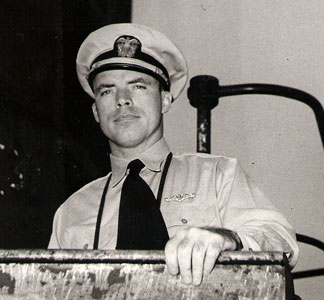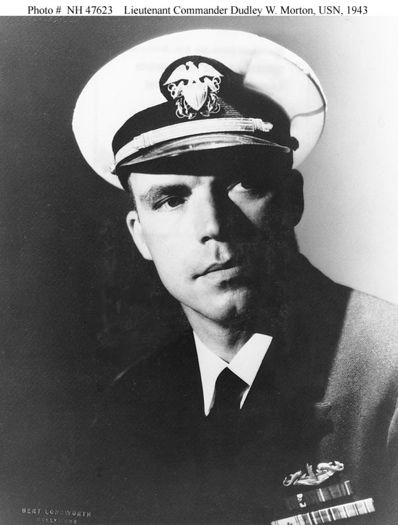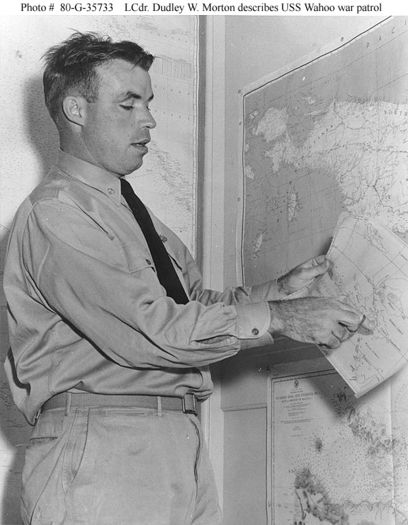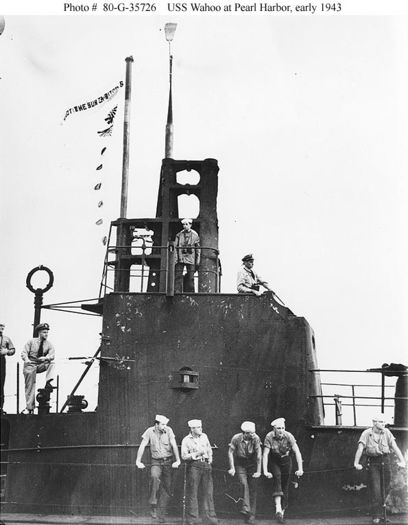DUDLEY W. MORTON, CDR, USN
Dudley Morton '30
Lucky Bag
From the 1930 Lucky Bag:
DUDLEY W. MORTON
Miami, Florida
"Mushmouth" "Mush" "Dud"
WELL, folks, here we are down in the land of palms and sunshine, with a balmy sea breeze blowing off Biscayne Bay. Everybody's happy! And "Mushmouth" seems to have brought along a goodly supply of that same Florida sunshine and happiness. A cheery "wha' d'ye say, Tillie." and his famous smile is enough to drive away any case of the blues. Once during the V. M. I. wrestling match, when Navy's heavyweight was having difficulty with V. M. I.'s two hundred and fifty pounds of avoirdupois and pugnacity, Mush rushed over to Coach Schutz, apparently all hot and bothered:
"Substitute Crane, substitute Crane!" he whispered, "Meeker's getting tired."
Dud excelled in football and wrestling during his four years here, and only a series of injuries have prevented him from attaining the honor that would otherwise have been his. Dud's ever-ready sense of humor and charming personality have made him admired of many; while a heart of gold and a vast appreciation and understanding of others have made Dud beloved of those who are so fortunate as to really know the man behind the smile.
Plebe Varsity Football "30"; Varsity Football 3, 2, 1, NA; Plebe Varsity Wrestling W30T; Varsity Wrestling, NA, 3, WNT 2, 1; Gymkhana Committee 4, 3; Pep Committee 4, 3, 2, 1; Class Crew 3.

DUDLEY W. MORTON
Miami, Florida
"Mushmouth" "Mush" "Dud"
WELL, folks, here we are down in the land of palms and sunshine, with a balmy sea breeze blowing off Biscayne Bay. Everybody's happy! And "Mushmouth" seems to have brought along a goodly supply of that same Florida sunshine and happiness. A cheery "wha' d'ye say, Tillie." and his famous smile is enough to drive away any case of the blues. Once during the V. M. I. wrestling match, when Navy's heavyweight was having difficulty with V. M. I.'s two hundred and fifty pounds of avoirdupois and pugnacity, Mush rushed over to Coach Schutz, apparently all hot and bothered:
"Substitute Crane, substitute Crane!" he whispered, "Meeker's getting tired."
Dud excelled in football and wrestling during his four years here, and only a series of injuries have prevented him from attaining the honor that would otherwise have been his. Dud's ever-ready sense of humor and charming personality have made him admired of many; while a heart of gold and a vast appreciation and understanding of others have made Dud beloved of those who are so fortunate as to really know the man behind the smile.
Plebe Varsity Football "30"; Varsity Football 3, 2, 1, NA; Plebe Varsity Wrestling W30T; Varsity Wrestling, NA, 3, WNT 2, 1; Gymkhana Committee 4, 3; Pep Committee 4, 3, 2, 1; Class Crew 3.
Loss
"Mush" was lost on October 11, 1943, when USS Wahoo (SS 238) was sunk by Japanese air and surface attack. He was the boat's commanding officer, and among the most successful American submarine skippers of the entire war.
Biography
From Naval History and Heritage Command:
Dudley Walker Morton was born in Owensboro, Kentucky, on 17 July 1907. He attended high school in Miami, Florida, and entered the U.S. Naval Academy in 1926. Commissioned in the rank of Ensign upon graduation in June 1930, he initially served in the aircraft carrier Saratoga and cruiser Chicago. In 1933, Lieutenant (Junior Grade) Morton reported to the Submarine Base, New London, for instruction as a submarine officer. Subsequently sent to the Asiatic Fleet, he was assigned to the submarine tender Canopus and submarine S-37. Lieutenant Morton returned to the United States in 1937, by way of Siberia and Europe, and took up new duties at the Philadelphia Navy Yard. He was Executive Officer of the destroyer Fairfax in 1939-40, followed by a tour as Commanding Officer of the small submarine R-5 that lasted until April 1942.
In mid-1942, Lieutenant Commander Morton joined Submarine Squadron FOUR as a Prospective Commanding Officer and briefly was in charge of the elderly submarine Dolphin. After making a patrol on the much-newer Wahoo as an observer, at year's end he became her Commanding Officer. Morton soon proved himself to be one of World War II's most daring and able submarine commanders, an inspiration to many of his colleagues during a period when the Pacific submarine force was shaking off excessively cautious tactical doctrines while simultaneously suffering under the dispiriting burden of unreliable torpedoes. In January and February 1943, he took Wahoo into the waters off northern New Guinea, where several Japanese ships were sunk or seriously damaged, among them the destroyer Harusame, torpedoed after an almost incredibly bold penetration of Wewak harbor, and the transport Buyo Maru.
From February into October 1943, Commander Morton took Wahoo on four more patrols, covering enemy-controlled waters in the shallow Yellow Sea, off Northern Japan and into the Sea of Japan. Continuing to use innovative attack techniques, including placing his Executive Officer at the periscope, thus allowing the captain to fully visualize the entire situation, he sank another sixteen ships. Only one patrol, in the Sea of Japan in August, was unproductive, with poor torpedo performance as a contributing cause. Morton and Wahoo returned to the same area in September, at a cost to the Japanese cargo fleet of four ships. However, on 11 October 1943 while exiting the Sea of Japan through La Pérouse Strait, Wahoo was lost with all hands.
In his five war patrols, Dudley W. Morton had sunk a total of nineteen enemy ships, of some 55,000 tons, making him one of the Pacific War's top three submarine commanders in terms of ships sunk. His achievements were recognized by the award of no less than four Navy Crosses, the last one posthumous, and a Presidential Unit Citation for Wahoo.
The destroyer USS Morton (DD-948), 1959-1992, was named in honor of Commander Dudley W. Morton.
His wife was listed as next of kin. He was also survived by his son, Douglas, who was born in 1939, and a daughter, Edwina.
Mush has a memory marker in Arlington National Cemetery.
Remembrances
From Wikipedia:
In 1960 Vice Admiral Charles A. Lockwood, Jr., ComSubPac during the war, was asked to write the foreword for former Wahoo crewmember Forest Sterling's book, Wake of the Wahoo. He wrote about Morton, "When a natural leader and born daredevil such as Mush Morton is given command of a submarine, the result can only be a fighting ship of the highest order, with officers and men who would follow their skipper to the Gates of Hell…. And they did." Added Lockwood, "Morton lined up an impressive number of 'firsts' during the short ten months that he commanded Wahoo: first to penetrate an enemy harbor and sink a ship therein; first to use successfully a down the throat shot; and first to wipe out an entire convoy single-handed."
From Hall of Valor:
The President of the United States of America takes pleasure in presenting the Navy Cross to Lieutenant Commander Dudley Walker Morton (NSN: 0-63274), United States Navy, for extraordinary heroism in the line of his profession as Commanding Officer of the U.S.S. WAHOO (SS-238), on the THIRD War Patrol of that submarine during the period 16 January 1943 to 7 February 1943, in enemy controlled waters of Pacific War Area during action against enemy Japanese forces which resulted in the sinking of 31,890 tons of enemy shipping. Ingeniously devising an improvised chart of a little known hostile territory, Lieutenant Commander Morton, displaying fearless initiative, utilized the chart as his guide and entered hazardous waters where he attacked and sank an enemy destroyer. Later, he engaged an unescorted Japanese convoy in a fourteen-hour running battle and, tirelessly pursuing his objective in the face of heavy gunfire, successfully accomplished the destruction of four important vessels. His inspiring leadership, keen judgment, and daring aggressiveness were in keeping with the highest traditions of the United States Naval Service.
General Orders: Pacific Fleet Board Awards: Serial 32 (June 21, 1943)
Service: Navy
Rank: Lieutenant Commander
From Hall of Valor:
The President of the United States of America takes pleasure in presenting a Gold Star in lieu of a Second Award of the Navy Cross to Lieutenant Commander Dudley Walker Morton (NSN: 0-63274), United States Navy, for extraordinary heroism in the line of his profession as Commanding Officer of the U.S.S. WAHOO (SS-238), on the FOURTH War Patrol of that submarine during the period 23 February 1943 to 6 April 1943, during action against enemy Japanese forces in the East China Sea. During vital operations in an extremely hazardous area, Commander Morton directed the effective torpedo and gunfire of his ship with outstanding professional skill and excellent judgment accounting for eight enemy vessels, a trawler and two sampans, a total of 36,693 tons, as well as damaging a 5,973-ton freighter. The brilliant leadership and valiant devotion to duty displayed by Commander Morton throughout the entire period of action reflect great credit upon his command and the United States Naval Service.
General Orders: Commander In Chief Pacific Fleet: Serial 0938 (April 22, 1943)
Service: Navy
Rank: Lieutenant Commander
From Hall of Valor:
The President of the United States of America takes pleasure in presenting a Second Gold Star in lieu of a Third Award of the Navy Cross to Lieutenant Commander Dudley Walker Morton (NSN: 0-63274), United States Navy, for extraordinary heroism in the line of his profession as Commanding Officer of the U.S.S. WAHOO (SS-238), on the FIFTH War Patrol of that submarine during the period 25 April 1943 to 21 May 1943, during action against enemy Japanese forces in the hostile waters of the Sea of Japan. With outstanding skill and courage, Commander Morton delivered aggressive torpedo attacks against hostile vessels and succeeded in damaging or sinking a large amount of enemy shipping. His daring leadership and indomitable fighting spirit and the gallant devotion to duty of his command were in keeping with the highest traditions of the United States Naval Service.
General Orders: Commander In Chief Pacific Fleet: Serial 01623 (July 11, 1943)
Service: Navy
Rank: Lieutenant Commander
From Hall of Valor:
The President of the United States of America takes pride in presenting a Third Gold Star in lieu of a Fourth Award of the Navy Cross (Posthumously) to Lieutenant Commander Dudley Walker Morton (NSN: 0-63274), United States Navy, for extraordinary heroism in the line of his profession as Commanding Officer of the U.S.S. WAHOO (SS-238), on the SEVENTH War Patrol of that submarine during the period 9 September 1943 to 11 October 1943, in action against enemy vessels in the Sea of Japan. With the utmost skill and daring, Commander Morton conducted three highly successful war patrols in Japanese-controlled waters, inflicting heavy losses on enemy shipping, and, courageously entering dangerous, confined and shallow waters on a subsequent vital mission, accomplished the complete destruction of at least one important hostile ship. Commander Morton's brilliant tactical ability and inspiring leadership throughout these extremely hazardous operations reflect great credit upon himself, his command and the Unites States Naval Service.
General Orders: Submarine Board of Awards: Serial 0085 (December 2, 1943)
Service: Navy
Rank: Lieutenant Commander
Distinguished Service Cross
(Note: The Distinguished Service Cross is an Army medal that is equivalent to the Navy Cross.)
From Hall of Valor:
The President of the United States of America, authorized by Act of Congress July 9, 1918, takes pleasure in presenting the Distinguished Service Cross to Lieutenant Commander Dudley Walker Morton (NSN: 0-63274), United States Navy, for extraordinary heroism in connection with military operations against an armed enemy while serving as Commanding Officer of the Submarine U.S.S. WAHOO (SS-238), in action against enemy forces in the Southwest Pacific Area during the period 24 to 26 January 1943. Attacking an enemy destroyer in the harbor of Wewak, New Guinea, Lieutenant Commander Morton, Commanding the Submarine U.S.S. WAHOO (SS-238), sank this vessel and then continued the attack on a hostile convoy proceeding to reinforce the enemy forces in New Guinea. By courageous action he destroyed completely every vessel of the convoy, which included two cargo ships, a tanker and a troop transport, contributing outstandingly to the success of operations in New Guinea.
General Orders: Headquarters, South West Pacific Area, General Orders No. 16 (1943)
Service: Navy
Rank: Lieutenant Commander
Photographs
Describes his submarine's successful third war patrol, during a press conference at Pearl Harbor, circa mid-February 1943. He is holding a rough chart of what appears to be a small part of the northern New Guinea coast. On the wall at right are charts of western New Guinea and of the Iron Bottom Sound area between Guadalcanal and Tulagi.
At Pearl Harbor, soon after the end of her third war patrol, circa 7 February 1943. Her Commanding Officer, Lieutenant Commander Dudley W. Morton, is on the open bridge, in right center. Officer standing at left appears to be the Executive Officer, Lieutenant Richard H. O'Kane. Note: broom lashed to the periscope head, indicating a "clean sweep" of enemy targets encountered; pennant bearing the slogan "Shoot the sunza bitches" and eight small flags, representing claimed sinkings of two Japanese warships and six merchant vessels. Note that the forward radar mast, mounted in front of the periscope shears, has been censored out of this photograph.
From the book "These Men Shall Never Die" by Lowell Thomas.
Namesake
USS Morton (DD 948) was named for Mush; the ship was sponsored by his daughter.
The "Register of Commissioned and Warrant Officers of the United States Navy and Marine Corps" was published annually from 1815 through at least the 1970s; it provided rank, command or station, and occasionally billet until the beginning of World War II when command/station was no longer included. Scanned copies were reviewed and data entered from the mid-1840s through 1922, when more-frequent Navy Directories were available.
The Navy Directory was a publication that provided information on the command, billet, and rank of every active and retired naval officer. Single editions have been found online from January 1915 and March 1918, and then from three to six editions per year from 1923 through 1940; the final edition is from April 1941.
The entries in both series of documents are sometimes cryptic and confusing. They are often inconsistent, even within an edition, with the name of commands; this is especially true for aviation squadrons in the 1920s and early 1930s.
Alumni listed at the same command may or may not have had significant interactions; they could have shared a stateroom or workspace, stood many hours of watch together… or, especially at the larger commands, they might not have known each other at all. The information provides the opportunity to draw connections that are otherwise invisible, though, and gives a fuller view of the professional experiences of these alumni in Memorial Hall.
October 1930
LT William Sample '19 (Scouting Plane Squadron (VS) 2B)
LTjg Walter Leach, Jr. '24 (Fighting Plane Squadron (VF) 6B)
LTjg Creighton Lankford '25 (Fighting Plane Squadron (VF) 1B)
LTjg Carlton Hutchins '26 (Fighting Plane Squadron (VF) 6B)
LTjg Charles Signer '26 (Fighting Plane Squadron (VF) 6B)
LTjg Robert Symes '27 (Torpedo and Bombing Plane Squadron (VT) 2B)
LTjg Renwick Calderhead '27 (Torpedo and Bombing Plane Squadron (VT) 2B)
LTjg John Eldridge, Jr. '27 (Scouting Plane Squadron (VS) 2B)
LTjg Julian Greer '27 (Fighting Plane Squadron (VF) 6B)
ENS Weldon Hamilton '28 (Torpedo and Bombing Plane Squadron (VT) 2B)
January 1931
LT William Sample '19 (Scouting Plane Squadron (VS) 2B)
LTjg Walter Leach, Jr. '24 (Fighting Plane Squadron (VF) 6B)
LTjg Creighton Lankford '25 (Fighting Plane Squadron (VF) 1B)
LTjg Carlton Hutchins '26 (Fighting Plane Squadron (VF) 6B)
LTjg Charles Signer '26 (Fighting Plane Squadron (VF) 6B)
LTjg Robert Symes '27 (Torpedo and Bombing Plane Squadron (VT) 2B)
LTjg Renwick Calderhead '27 (Torpedo and Bombing Plane Squadron (VT) 2B)
LTjg John Eldridge, Jr. '27 (Scouting Plane Squadron (VS) 2B)
LTjg Julian Greer '27 (Fighting Plane Squadron (VF) 6B)
ENS Weldon Hamilton '28 (Torpedo and Bombing Plane Squadron (VT) 2B)
October 1931
January 1932
April 1932
October 1932
January 1933
LTjg William Pennewill '29 (Scouting Plane Squadron (VS) 10S)
April 1933
LTjg William Pennewill '29 (Scouting Plane Squadron (VS) 10S)
July 1933
October 1933
April 1934
July 1934
October 1934
January 1935
April 1935
October 1935
January 1936
April 1936
July 1936
January 1937
April 1937
CAPT David Claude '24 (Marine Corps Schools, Marine Barracks)
ENS Graham Bright '35 (Naval Finance & Supply School)
2LT Robert Moore '36 (Marine Corps Schools, Marine Barracks)
2LT Ralph Haas '36 (Marine Corps Schools, Marine Barracks)
September 1937
2LT Robert Moore '36 (Marine Corps Schools, Marine Barracks)
2LT James Bromeyer '37 (Marine Corps Schools, Marine Barracks)
2LT Alben Robertson '37 (Marine Corps Schools, Marine Barracks)
2LT Radford West '37 (Marine Corps Schools, Marine Barracks)
January 1938
2LT James Bromeyer '37 (Marine Corps Schools, Marine Barracks)
2LT Robert Ruge '37 (Marine Corps Schools, Marine Barracks)
2LT Radford West '37 (Marine Corps Schools, Marine Barracks)
July 1938
LTjg Edward Allen '31 (Naval Aircraft Factory)
2LT James Owens '38 (Marine Corps Schools, Marine Barracks)
2LT Douglas Keeler '38 (Marine Corps Schools, Marine Barracks)
2LT Dorrance Radcliffe '38 (Marine Corps Schools, Marine Barracks)
January 1939
LTjg Edward Allen '31 (Naval Aircraft Factory)
ENS Louis Gulliver, Jr. '36 (Naval Finance and Supply School)
2LT James Owens '38 (Marine Corps Schools, Marine Barracks)
2LT Douglas Keeler '38 (Marine Corps Schools, Marine Barracks)
2LT Dorrance Radcliffe '38 (Marine Corps Schools, Marine Barracks)
October 1939
November 1940
April 1941

The "category" links below lead to lists of related Honorees; use them to explore further the service and sacrifice of alumni in Memorial Hall.






